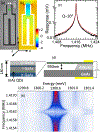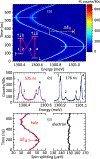Spin-Mechanical Coupling of an InAs Quantum Dot Embedded in a Mechanical Resonator
- PMID: 30608739
- PMCID: PMC6527321
- DOI: 10.1103/PhysRevLett.121.246801
Spin-Mechanical Coupling of an InAs Quantum Dot Embedded in a Mechanical Resonator
Abstract
We demonstrate strain-induced coupling between a hole spin in a quantum dot and mechanical motion of a cantilever. The optical transitions of quantum dots integrated into GaAs mechanical resonators are measured synchronously with the motion of the driven resonators. In a Voigt magnetic field, both electron and hole spin splittings are measured, showing negligible change for the electron spin but a large change for the hole spin of up to 36%. This large effect is attributed to the stronger spin orbit interaction of holes compared to electrons.
Figures



References
-
- Schwab KC and Roukes ML, Phys. Today 58, No. 7, 36 (2005).
-
- Ramos T, Sudhir V, Stannigel K, Zoller P, and Kippenberg TJ, Phys. Rev. Lett 110, 193602 (2013). - PubMed
-
- Wilson-Rae I, Zoller P, and Imamoḡlu A, Phys. Rev. Lett 92, 075507 (2004). - PubMed
-
- Bennett SD, Kolkowitz S, Unterreithmeier QP, Rabl P,Jayich ACB, Harris JGE, and Lukin MD, New J. Phys 14, 125004 (2012). - PubMed
-
- Rabl P, Kolkowitz SJ, Koppens FHL, Harris JGE, Zoller P, and Lukin MD, Nat. Phys 6, 602 (2010).
Grants and funding
LinkOut - more resources
Full Text Sources
